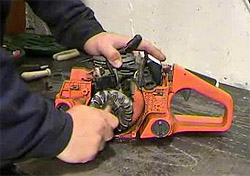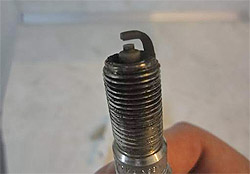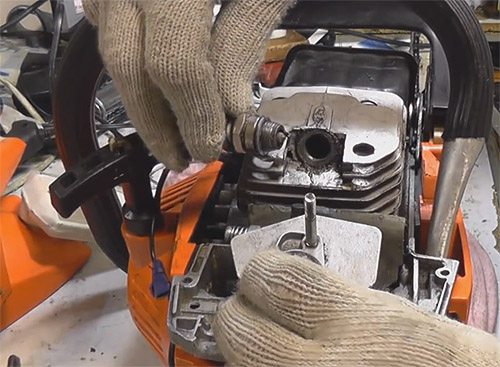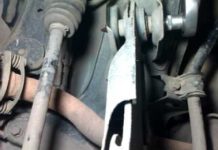It often happens that during prolonged operation, the walls of the exhaust pipe are covered with carbon deposits, which prevents the free exit of exhaust gases.
In this case, remove the muffler (if possible) and wash it with detergents, then dry thoroughly with a hairdryer.
ATTENTION! Carbon deposits contain carcinogens. During dry brushing, it can enter the lungs and pose a threat to your health.
Carbon deposits are usually caused by an incorrect gasoline-oil ratio or the use of poor quality and incompatible oil.
Carefully read the instruction manual for your chainsaw to prevent this from happening in the future.
The worn out cylinder and piston, the appearance of scratches and seizures on their surface, wear of the piston rings or crankshaft bearings - all these are very serious damages. As a result, they lead to a pressure drop in the cylinder. In this case, it will be very difficult to start the engine.
Without disassembly, you can check the state of the CPG as follows. Remove the muffler and look out the window that opens. Part of the cylinder surface will be visible. To obtain information about the state of the CPG, the compression in the engine is measured using a compression gauge, which must be installed in the spark plug hole. Turning the crankshaft (you can use a starter), measure the readings of the device. Compressor readings must be at least 8-9 kgf / cm2 (or 0.8-0.9 MPa).
If there is no compression gauge, you can estimate the presence of compression by eye by simply plugging the hole in the plug socket with your finger and pulling the starter, as shown in the photo below:
Coked piston rings or wear can be the cause of low compression.
Each instruction manual indicates the need to monitor the condition of the chain lubrication system.
Typically, system malfunctions occur due to clogged channels through which the lubricant is supplied. If there is a slight leakage of oil, you can continue to operate. But if the oil leaks are large enough, then you need to check the tightness of the connection of the pipes to the pump unions. The leak can be eliminated by using a sealant or by replacing the tubes.
You should also pay attention to the condition of the oil pump. If there are cracks in its housing, replacement is required.
VIDEO
If the chain brake does not work, then the reason may be contamination of the brake band with grease or sawdust with tree resin or under the cover space.
The problem can be corrected by cleaning the dirt and replacing the brake band.
***
Chainsaw prices are falling and this makes them more popular and affordable not only for professionals, but also for simple, so to speak, amateurs. However, a widespread dependence - the lower the price, the less reliable the device and more often malfunctions appear, is also relevant for a chainsaw. But for a chainsaw of any price range, most malfunctions can be avoided with proper operation, care and timely maintenance of equipment. But from the breakdown of the chainsaw, as well as any other equipment, no one is insured. Therefore, it is proposed to consider the main types of chainsaw malfunctions, methods of their diagnosis, elimination and repair .
All the main malfunctions of chainsaws can be roughly divided into two main categories:
Here are the various disturbances in the operation of the chainsaw engine that occur most often. The main such malfunctions are reduced to the following symptoms:
the engine does not start (it is quite general and the reasons can be quite different);
starts up, but often stalls;
does not develop power, i.e. works normally at idle, but stalls or “chokes” under load.
Smokes very much, power drops.
It is very important to correctly determine the cause of the malfunction, because otherwise we simply cannot eliminate it. If, when trying to start the chainsaw, there are no extraneous sounds (knocking, grinding, etc.), then very often it turns out that there is actually no breakdown. For example, if it is not correct to start the chainsaw and pull on the suction for a long time, then the engine simply floods and it is very difficult to start it.
In order to properly start a cold chainsaw engine, set the lever or switch to the “choke closed” position. Then you need to pump the mixture into the carburetor, if there is a fuel pump available. Pull the starter handle until the engine resistance is felt, and pull vigorously in amplitude, moving the hand to the side. After two or three such movements, the engine must first start and then stall. If this does not happen, then it is necessary to move the lever to the half-throttle position or simply to the working position and continue to start the chainsaw in this mode. In many chainsaws, the "half-throttle" is fixed automatically when the air damper is pulled. Some models have an ignition rocker switch, it is important to make sure it is on.
If the engine won't start, the first thing to do is unscrew and inspect the spark plug. There are cases, at the plant in the cold season, the combustion chamber is poured with fuel. Then you also need to unscrew the candle, dry the combustion chamber with an idle plant, clean the candle, screw in and start again. It is advisable to immediately check for the presence of a spark - we put it on a cap with a high-voltage wire on the twisted candle, put it on the cylinder and pull the starter. Visually, we observe a frequent blue spark - good. We screw the candle into place and start. If there is no spark, change the candle and try again. Again, no - we check the connection of the high-voltage wire to the spark plug, coil and ignition system.
In general, the condition of the candle can be used to judge the type of malfunction.
Dry. Most likely, the fuel mixture does not enter the cylinder. It's not about the ignition system, so the plug is screwed back in and the fuel supply system is checked.Wet and heavily splashed with fuel. The reason for the excess fuel mixture lies either in the violation of the starting rules, as described above, or in the incorrect adjustment of the carburetor.Covered with black carbon. This may indicate the use of low-quality oil, an incorrectly adjusted carburetor, or an incorrectly calculated gasoline to oil ratio. The candle should be washed, cleaned of carbon deposits with a sharp object (awl or needle), wipe the electrodes with a sandpaper and put in place.When checking the candle, you need to pay attention to the gap between the electrodes: it is considered normal from 0.5 to 0.65 mm. A damaged or worn gasket must be replaced.
A properly adjusted chainsaw carburetor ensures that your chainsaw operates efficiently at full power while using the most fuel efficiently.
The need to adjust the carburetor of a chainsaw arises infrequently, since the adjustment is initially carried out by the manufacturer to achieve optimal operation. The adjusting screws are designed for more precise adjustment of the chainsaw carburetor, if necessary.
When and why does this need arise?
Among the reasons for the failure to fix the adjusting screws, the most common are the following:
Strong vibration or damage to the protective cover. This rarely happens, but it does happen.
Serious engine wear (piston). Of course, in this case, it is worth taking more care of repairing the chainsaw engine, but still adjusting the carburetor can improve its functionality for a while.
Clogged carburetor due to damaged air filter, poor quality gasoline, or scale formation. In this case, in addition to adjusting the carburetor, flushing the carburetor cannot be avoided.
What signs indicate the need to adjust the chainsaw carburetor?
Firstly, the engine does not start, or it starts, but then it stalls. This is most often due to a lean fuel mixture.
Secondly, a significant increase in fuel consumption and exhaust emissions.An increase in exhaust emissions indicates that the fuel does not burn completely, which means that the oversaturation of the fuel mixture may be the cause.
Chainsaw carburetor adjustment scheme may differ slightly depending on the manufacturer (the process of adjusting the chainsaw carburetor of a particular brand and model is described in detail in the operating instructions), but the general principles remain the same for all brands. The purpose of the saw adjustment is to change the quantity and quality (richness) of the fuel mixture supplied to the engine cylinder.
To find out how to adjust the carburetor on a chainsaw, you need to learn to distinguish between three screws (some models have only one).
The L and H screws are similar only in appearance, in fact, they are different
Each screw has its own letter designation:
"L" is for setting low rpm;
"H" is needed to adjust the upper speed;
"T" is needed to adjust idle speed (only one is present on models with one screw).
There are mandatory safety requirements that must be observed when adjusting the carburetor of any chainsaw:
Make sure the chain is facing away from you.
The saw must be firmly positioned on a level surface, and its cutting edge must not touch any objects.
Please note: the exact values of the angle of rotation of the adjusting screws can be found in the operating instructions for your specific model of chainsaw. Strict adherence to the manufacturer's instructions will help you avoid engine damage.
The process of tuning the carburetor of a chainsaw consists of two stages: basic (engine off) and final (running warm engine).
Slowly turn the maximum and minimum speed adjusting screws (H and L) clockwise until they stop, then turn counterclockwise 1.5 turns.
Before this stage of adjustment, it is necessary to warm up the engine for 5-10 minutes, avoiding high revs.
Turn the idle speed adjustment screw (T / LA / S) counterclockwise until the minimum engine speed is reached. Make sure the chain does not move. That is, if the engine stops idling, turn the idle adjustment screw clockwise. If the chain is in motion, remove the screw counterclockwise.
To complete the adjustment of the carburetor of the chainsaw, it is necessary to check the engine for acceleration and maximum rpm.
To check the engine for acceleration, gently press the accelerator and make sure that the engine quickly picks up speed from idle to maximum (from 2800 to 11500-15000 rpm - depending on the brand and model of the saw). If the engine revs up slowly, slowly unscrew the screw L counterclockwise (no more than 1/8 of a turn).
The maximum number of revolutions is adjusted using screw H. The revolutions increase when it is turned clockwise, and decreases when it is turned counterclockwise.
The highest rotational speed of chainsaw engines varies from 11,500 to 15,000 rpm. Higher speeds can be hazardous to the engine and are simply not provided by the ignition. Therefore, the maximum rpm can be determined by the occurrence of misfiring. If they appear, slightly unscrew the screw H counterclockwise.
After you have adjusted the acceleration and maximum engine speed, be sure to re-check the operation of the chainsaw at idle speed. With a properly adjusted carburetor, the following conditions must be met:
at idle speed, the chain should not move;
the engine must pick up speed quickly;
the operation of the engine should resemble a four-stroke engine.
If the operation of the chainsaw does not meet at least one of these conditions, the adjustment procedure (with the exception of the basic stage) will have to be repeated again.
You also need to check the muffler. If it is collapsible, then we disassemble and inspect, remove all carbon deposits. In some models of chainsaws, the muffler will have to be twisted, otherwise it is not possible to check. The non-dismountable muffler is dried with a hairdryer after washing. Remember that carbon deposits contain substances that are carcinogenic and should not be dry cleaned that could cause them to inhale. When removing the muffler, plug the engine outlet with a clean cloth. Do not underestimate this breakdown - the muffler will clog, the chainsaw will lose power or will not start at all. One of the reasons why the muffler can clog is the use of a fuel mixture with an excessive amount of oil (the amount of oil is more than the manufacturer recommends), and the use of either oil that is not intended for two-stroke engines or low-quality oil.
A rare chainsaw repair manual dispenses with mentioning chain lubrication system malfunctions, which are quite common. They usually manifest themselves in the lack of or insufficient supply of lubricant to the chain and in oil leaks. If the chain is dry, the first step is to inspect and clean the channels that supply oil to the bar. Driving them is not uncommon.
In case of significant (small is considered normal) oil leakage, it is necessary to check the tightness of the connection of the pipes to the pump unions. They can subside or crack. Violation of the tightness of the oil line, in addition to drips, can lead to insufficient lubrication of the chain. The pump begins to suck in air, which affects its performance. The violation of the tightness is eliminated by replacing the tubes or sealing them with a sealant.
Oil pumps are of different designs and their drive can also be carried out in different ways. Very often there is no need to change the entire oil pump, it is enough to change its moving part called a plunger, it is often it that fails due to the ingress of a large amount of dirt and sawdust, it just wedges and licks its edges. The oil pump is usually driven by a drive sprocket or a special gear on the crankshaft.
The most serious failure of the lubrication system is cracks in the oil pump housing. In this case, it will have to be replaced.
Failure of the chain brake can occur due to contamination of the under-cover space and brake band with sawdust or grease. The wear of the belt also leads to the same. In the first case, you need to clean the lid space, in the second, replace the brake band.
If there is a brushcutter in the household - use, maintenance and repair - to help you. Moreover, you can make a lawn mower yourself from a chainsaw, thus unifying the tool.
The chainsaw is a worthy replacement for hand saws and axes. Today, this tool is available in almost every household - it is indispensable for setting up a personal plot, construction and repair work. Intensive use and improper care of the tool can lead to premature failure. However, the owner of the chainsaw does not have to go to the workshop right away - many of the faults that can happen to her during operation are quite realistic to eliminate on their own.
Correct diagnosis is essential for a successful repair. Therefore, in order to determine why the chainsaw failed and, most importantly, how to make it work again, you first need to know the features of its design.
It should be noted that it does not differ in particular complexity, since it includes:
engine (two-stroke gasoline);
functional part (saw bar and chain);
systems that ensure the joint operation of these two units (ignition, filtration, lubrication, etc.), that is, the tool as a whole.
In order to simplify the diagnosis of malfunctions, it is customary to distinguish them into two main categories:
engine malfunctions;
malfunctions of other parts of the chainsaw.
Most often, failures occur in the engine systems, however, the rest of the tool, due to intensive use or improper care, can fail at any time. How to determine exactly where the breakdown occurred? Simple logic will help us with this.
If the problem is in the engine, it will:
do not start;
deafen;
work unstable;
overheat;
smoke;
develop insufficient power.
As for all other malfunctions, as a rule, they manifest themselves with a normally operating motor.
If your chainsaw won't start, the first thing to do is to check for a mixture of fuel in the tank. By the way, it must be prepared in the proportions indicated by the engine manufacturer, otherwise the instrument will simply not start.
After verifying that the fuel mixture is correct and available, the ignition system should be checked. To do this, you need to inspect the spark plug.
Her condition can say a lot:
indicates that the fuel mixture does not enter the carburetor, which means that the problem is not in the ignition;
is the result of an overabundance of the fuel mixture, which lies either in a violation of the engine starting algorithm or in an incorrect carburetor adjustment;
this is a signal about the presence of low-quality oil in the engine lubrication system, incorrect carburetor settings, or an incorrectly prepared fuel mixture.
If the spark plug is splashed with fuel, wipe it thoroughly after removing it. The fuel supply system should also be cleaned. To do this, it overlaps, after which the starter is turned on. A carbonized candle must be carefully cleaned with an awl and emery.
When checking the spark plugs, you should pay attention to the distance between the electrodes (the normal gap is 0.5-0.65 mm), as well as the condition of the gasket and the presence of a spark. A damaged or worn gasket will have to be replaced, and the spark can be checked by putting on the ignition cable, connecting the cylinder and plug nut, and starting the starter.
If the discharge does not occur, the plug must be replaced. In the event that a spark does not appear with a new candle, then the problem is in the connection to the high-voltage wire or in it itself.
If the fuel mixture does not flow into the cylinder, but the spark plug is working properly, this may mean that:
Clogged fuel filter.
To clean this unit, remove the fuel hose and check the jet. If it is weak, the filter must be removed through the filler hole of the fuel tank and cleaned or replaced if completely worn out.
As a preventive measure, it is recommended to replace the fuel filter at least once every 3 months.
This is nothing more than a hole in the fuel tank cap, which is cleaned out with an awl.
The fuel mixture is not supplied or is supplied insufficiently.
There may be several reasons for this:
the air filter is clogged (in this case, it must be removed, rinsed with water, dried and replaced);
the carburetor settings are out of order (which means this unit needs to be re-adjusted);
the integrity of the carburetor membrane is broken (must be replaced);
the channels of the carburetor are clogged (it must be disassembled and all parts and assemblies must be cleaned).
If at low speeds the engine of the chainsaw works normally, but at high speeds it starts to stall and smoke, the problem may be hidden in the muffler.
To check the quality of its work, you should do:
dismantling (with the obligatory closing of the outlet);
disassembly (if the muffler is collapsible);
cleaning from carbon deposits using special detergents or dry method;
drying (using a hair dryer);
reassembly and assembly.
Dry cleaning without respiratory protection is not recommended. The carcinogens present in the soot will be released into the surrounding atmosphere in the form of dust, the inhalation of which is extremely hazardous to health.
To prevent clogging of the muffler during the operation of the chainsaw, you should carefully monitor the composition of the fuel mixture and the quality of its components.
If the chainsaw engine does not start or cannot develop normal power, it is likely that sufficient pressure does not build up in the engine cylinder for combustion of the fuel mixture. The reason for this may be the wear of the elements of the cylinder-piston group - the piston, rings, bearings, etc. In order to assess the condition of this unit, it should be visually inspected, having previously removed the muffler.
For a more complete diagnosis, a compression gauge is placed in the spark plug hole of the two-stroke engine of the chainsaw. It measures the compression in the engine. Based on the results of the check, one can judge the state of the CPG, however, the exact facts can only be obtained with a complete disassembly of the unit.
If the piston is chipped or scratched, it will obviously need to be replaced. The same applies to deformed or broken piston rings - for normal engine operation, they must be completely intact and free of carbon deposits.
A properly working carburetor guarantees maximum efficiency of the chainsaw, that is, it is possible to develop full power with the most economical consumption of the fuel mixture. The adjustment of this unit is usually carried out by the manufacturer, but its design provides for the possibility of adjustment already during operation.
The fact that such a setting will have to be performed by the owner of the chainsaw is evidenced by:
Strong vibrations or damage to the protective cover.
CPG wear.
Carburetor clogged.
Inability to start the engine or its spontaneous stops after starting.
Increase in fuel consumption and emissions while decreasing engine power.
Chainsaw carburetor adjustment is carried out in strict accordance with the manufacturer's instructions using three special screws, which are responsible for the maximum ("M") and minimum ("L") revolutions, as well as the idle speed of the engine ("T"). In order to exclude unwanted interference by an inexperienced user with the carburetor operation, some manufacturers install only one idle screw.
Carburetor adjustment is carried out in two stages:
Basic (carried out with the engine off).
Finishing (carried out with a running, pre-warmed engine).
For basic adjustment, screw in screws H and L as far as the stop and back out 1.5 turns. Final adjustments require the engine to warm up for 5-10 minutes at low revs.
The final calibration is performed by unscrewing the idle screw until the minimum engine speed is reached (in this case, its operation must be stable, and the chain must be stationary). If the engine stops at idle speed, the screw must be returned back, and if the saw chain is still in motion, continue turning counterclockwise.
Calibration check is performed by test:
Acceleration (with a smooth press on the accelerator, the engine should quickly pick up speed to the maximum indicator).
Maximum speed (if there is an ignition interruption, screw H should be slightly loosened).
Work at idle speed (the chain should not move, and the engine should pick up speed as quickly as possible).
If the owner of the chainsaw is not familiar with the carburetor device and does not have the tool necessary to calibrate it, contact a specialist.The carburetor is a very complex unit, so any wrong action can lead to irreversible consequences, for example, complete engine failure.
If the diagnostics showed that everything is in order with the engine and its systems, then the cause of the malfunction should be looked for in other units of the chainsaw. The most common problems are:
failure of the starter;
improper operation of the lubrication system;
incorrect operation of the chain brake;
saw chain wear, etc.
If the cause of the tool failure is not visible to the naked eye, as is the case with the engine, it is necessary to perform a thorough diagnosis of the faults and eliminate them in accordance with the manufacturer's recommendations and safety regulations.
VIDEO
Chainsaws are available on the farm almost every resident of the village and many owners of summer cottages. They are easy to use and can be repaired by hand. Finding out the reason why the device does not start, troit, has problems with idling is not so difficult. Despite the types of chainsaws, the repair principles are the same.
Chainsaws are divided by class and purpose.
The purpose of the tool affects power, weight and dimensions. Chainsaws have three purposes:
Before you start disassembling and repairing your chainsaw, prepare the necessary tools and accessories:
Overalls.
Gloves.
Free space on the table.
Candle wrench with screwdriver.
Chainsaw problems can be of two types:
Malfunctions of the engine, ignition system, fuel supply and exhaust.
Malfunctions of other components.
The following indicators will indicate that an engine diagnosis is required:
The tool will not start or will start and stall.
It is unstable.
It works at idle, and under load, the speed drops or stalls.
Lubrication system problems.
The chain brake does not work.
Broken or worn out chain.
The asterisk was worn out.
The appearance of the spark plug should be checked.
Take the CANDLE KEY. Remove the insulating cap with the power cable. Unscrew the candle with the key.
Fuel does not flow for three reasons:
There is a hole in the fuel filler cap that could be clogged. If this happens, a vacuum has formed, which prevents the fuel from flowing out.
A fuel filter is installed in the tank. It gets dirty over time.
Fuel is poorly supplied from the carburetor to the cylinder.
The first two reasons are identified in the same way. To do this, you must disconnect the hose through which the fuel flows from the carburetor. And check with what pressure it flows. If there is little or no leakage at all, then the tank cap is cleaned with a needle, and the fuel filter is replaced. But first you need to drain the combustible mixture and remove the filter from the tank with a wire hook. If fuel flows well from the disconnected hose, then the air filter is clogged or the carburetor is faulty. The air filter affects the flow of air into the carburetor and enrichment of the combustible mixture. When it is clogged, the mixture is too rich, as air does not come in. This affects the correct functioning of the engine.
Remove the air filter carefully to prevent dust from scattering. Cover the opening in the combustion chamber with a clean cloth.
Blow out the filter and clean with a soft brush. If the filter does not clean, rinse it. Put back after drying.
Before adjusting the carburetor, check that the air filter is clean and that the chain is tight enough. Read the instructions. The manufacturer describes how to properly adjust the carburetor. If there is no instruction, locate the three labeled screws:
H - screw for maximum speed.
L - minimum speed screw.
S - screw for fine adjustment of idle speed.
Take a screwdriver to adjust the carburetor and get started.
Basic adjustment. Produced with the engine off and cold. Turn screws H and L all the way to the right, that is, clockwise.Then one and a half turn to the left.Idle speed adjustment. Before starting it, turn on and warm up the engine. Turning screw S to the right increases the speed, and to the left decreases it. You need to slow down and control so that the engine runs stably, without pauses. Make sure the chain is still. If the engine suddenly stops, increase the speed a little. And when moving the chain, decrease it.Checking the engine for acceleration. Smoothly press the fuel button. The adjusted engine should quickly and confidently pick up speed to the maximum. If the engine is lagging and runs unsteadily, turn the screw L to the left no more than an eighth of a turn.Adjustment of maximum speed. Ignition interruptions occur when maximum rpm is reached. Turn screw H slowly to the left until stability is achieved.After all adjustments, check that the engine is idling. It should work stably with the chain stationary. If you do not achieve the desired result, repeat all adjustments, excluding the basic one.When the muffler is clogged, the exhaust gases have nowhere to go. The saw will not run and will not start. The design of the chainsaw allows you to quickly remove the muffler. You may need an Allen key or socket wrench, depending on the mounting method.
Unscrew the screws. Swinging the muffler slightly, remove it from the studs. Plug the hole in the engine with a clean cloth.
The muffler is dirty due to poor quality oil or improper fuel mixture.
VIDEO
Wear and damage to the cylinder-piston group make it impossible to start the engine.
Remove the muffler to find damage. You will see an exhaust hole, in which you will see a part of the cylinder surface.
Part of the cylinder in the exhaust port
In addition to the piston, which may not have visible damage through this hole, inspect the piston ring. If defects are present, then it is necessary to disassemble the entire piston group in order to fully assess its condition. Malfunctions can be eliminated only by complete replacement of the group.
Take a pressure gauge to measure the compression. Screw into the spark plug hole by gently pressing the sealing gum.
Pull the starter, observing the arrow of the device.
The pressure must be at least 8 atmospheres.
If there is no such device, try the folk method. Unscrew the spark plug.
Compression check in the folk way
Plug the spark plug hole with your finger and pull the starter. If the finger sucks in, it means there is compression.
VIDEO
Violation of the integrity of the cutting links.
Crevices, abrasions and cracks in rivets and link sides.
The cutting link has worn out so that it is difficult to cut.
Connecting link damaged.
Change the tire and drive sprocket after replacing 3 chains.
To replace the sprocket, you will need: a spark plug wrench, a piston stopper, a clutch puller.
Remove the cover to gain access to the candle. Unscrew the candle with a key.
Use the clutch puller to turn the clutch clockwise to raise the piston to top dead center. This can be checked through the plug hole.
Install the piston stopper instead of the spark plug. If it is not there, then twist a thick bundle of ropes and insert it into the candle hole.
Use the puller to turn the clutch to the right and you will unscrew it.
Remove all parts of the clutch assembly and the plate with an asterisk in sequence. Replace it with a new one.
VIDEO
If the tire is not supplied with lubricant or is poorly supplied, then the chain and bar overheat, severe friction and wear occur. Check holes and passages through which grease flows. If they are clogged, they must be cleaned.
The oil pump housing is cracked. In this case, the pump must be replaced.
Leaking connection between pump and tube.
There are cracks on the tube.
All chainsaws have an oil supply adjustment. There is always a chain link and a drop of oil near the location of the adjusting screw on the housing. Turning to the right will decrease oil flow.For the winter, the oil supply is increased, for the summer, it is reduced. It is impossible to decrease strongly, as the tire will burn.
The brake stops working for the following reasons:
The brake cover melted. Replace the cover.
Video (click to play).
Chainsaws need regular cleaning of sawdust, dust, dirt, carbon deposits and replacement of spare parts. If you can do it yourself, you will save time and money.












